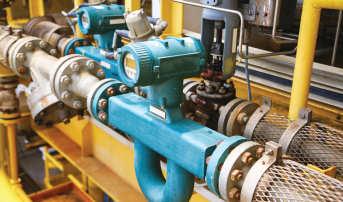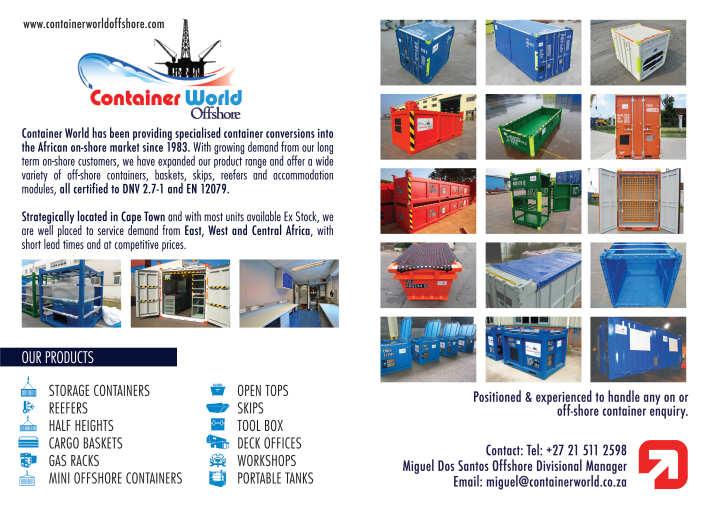
7 minute read
Cyber Security The energy sector must be prepared to fight complex cyber threats
BUILDING CYBER RESILIENCE THROUGH INDUSTRY COLLABORATION
As the digital transformation continues, the energy sector must be aware of increasingly common, creative and complex industrial cyber security threats, says Jalal Bouhdada, global segment director for Cyber Security at DNV and founder of Applied Risk.
SUCH IS THE concern among Middle Eastern and African energy professionals over cyber security threats in the sector that 69% believe that an attack is likely to cause loss of life.
This, compared with a global average of 57%, was just one of the findings of The Cyber Priority, a research report by DNV which was based on a survey of more than 940 energy professionals around the world and in-depth interviews with industry executives.
Exploring the state of cyber security in the energy sector, the report found that energy executives anticipate life, property, and environment-compromising cyber attacks on the sector within the next two years. Indeed, these could include attacks on energy supplies in power grids, ship navigational systems, windfarms and systems in pipelines. Attackers could be foreign powers, competitors or criminal gangs.
A recent example of a cyber attack on the energy sector came in October 2022 when Tata Power said that their IT infrastructure and systems had been hacked. Another, in 2020, saw hackers attempt to hack into the industrial control systems of five Israeli Water Authority facilities and try raise the level of chlorine in the nation’s water supply.
With OT becoming more networked and connected to IT systems, cyber criminals can more easily access control systems operating critical infrastructure. Safety is therefore a key risk with industrial fail-safe mechanisms designed for an offline world possibly having unknown vulnerabilities that could see them undermined if they are not protected against a cyber attack.
The Cyber Priority report revealed that while some energy organisations are making real progress toward cyber resilience, preventative action is lagging the growing threat. There is still a strong signal that the energy industry and other industrial sectors need to make urgent investments to ensure that cyber security incidents do not become the cause of future safety incidents.
One of the challenges with managing industrial cyber security risks is that there is not enough best practice available –particularly within older energy infrastructure that doesn’t have cyber security built into it by design – to guide operators, suppliers, manufacturers, and regulatory authorities in building an effective force of defence.
However, it is hoped that it does not take a tragic incident for the industry to prioritise and institutionalise safety protocols, standards, and regulation. This would draw parallels to trends in the industry’s physical safety practices when it took incidents such as the 1988 Piper Alpha oil platform explosion in the North Sea and the 2010 Deepwater Horizon oil spill in the Gulf of Mexico for there to be material change.
Where the energy industry has worked together to solve its safety challenges over the past 50 years, it has made extraordinary progress. Within a relatively short period of time, it implemented global standards, improved its ways of working and use of technology, and embedded a safety-first mindset across the entire workforce. There is no reason why a similar transformation is not only achievable in the field of cyber security –and before a tragedy happens.
While industry players are already beginning to come together to develop more best practice – such as the IEC 62443 standards for cyber security in operational technology in automation and control systems, and DNV’s Recommended Practice for its application in the oil and gas industry – we need to go further in taking collective action as industrial cyber security risks increasingly become seen as business risks.
Never has it been more important for companies and authorities to come together to share knowledge, create best practice and develop new standards in the fight against industrial cyber crime.
Image Credit: DNV
Jalal Bouhdada, global segment director for Cyber Security at DNV and founder of Applied Risk.
CALIBRATING FLOWMETERS FOR REAL-WORLD PROCESS EFFECTS
The oil and gas industry is favouring ‘newer’ and more ‘advanced’ flow measurement technologies, says Chris Mills, senior consultant engineer, TÜV SÜD National Engineering Laboratory.
THOUGH THE ADOPTION of Coriolis flow meters is a logical move, the effect of elevated conditions on their measurement uncertainty is generally not well understood by end users.
Several factors affect the performance of Coriolis devices, including temperature, pressure, fluid viscosity and the Reynolds number. However, meter manufacturers incorporate corrections in an attempt to compensate for these effects. Whilst calibrating ‘in-situ’ at service conditions can eliminate these effects, the industry appears to be moving away from proving meters onsite. The more favoured design appears to consist of Coriolis master and duty flow meters.
The Coriolis duty meter remains in-situ and the master meter is periodically sent to an accredited laboratory for a flow calibration to minimise oil and gas production downtime. The performance of the duty meter is then compared with the calibrated master meter. However, the temperature, pressure and fluid properties of produced oil and gas from a reservoir can differ considerably from conditions at the calibration laboratory.
Our research has explored the performance of Coriolis flow meters that have been calibrated in our elevated pressure and temperature (EPAT) oil flow facility and the UK National Standards oil flow facility in Glasgow.
We analysed the calibration results in terms of fluid viscosity, Reynolds number, temperature, pressure and flow rate to identify trends and to ascertain whether manufacturers’ performance claims were valid.
The experimental results used were from a combination of BEIS funded research, joint industry projects, internal TÜV SÜD National Engineering Laboratory research and commercial calibrations.
Overall, the research results reinforce the concept that Coriolis flow meters cannot simply be utilised at service conditions without suitable consideration, characterisation and calibration. It is vital that end users remember that pressure corrections published by manufacturers are not fully traceable at present.
Temperature – It is a significant effect for Coriolis flow meters. However, they have an onboard resistance temperature detectors (RTD) and incorporate algorithms to correct for temperature effects on the flow tube material. This means that the temperature effect is automatically corrected.
The temperature compensation coefficient cannot be easily modified by the end user. Instead, a more practical approach would be to calibrate

TÜV SÜD's flow meter test facilities.
Temperature, pressure, and the Reynolds number are the factors that effect Coriolis flow meters.”
the device as close to the service temperature as possible. This would allow to ascertain whether temperature effects are significant, and a correction allowed for via an adjustment to the Coriolis mass factor.
Pressure – As the pressure effect has shown to be linear, it can be corrected either via an adjustment to the meter mass factor, a static fixed pressure correction or a dynamic ‘live’ correction via a pressure transmitter. If the process conditions are stable, then a static fixed pressure correction could potentially be applied.
This involves the device being adjusted for the effects of pressure via an adjustment to the device mass factor or to the flow computer. However, it should be noted that if the pressure effect is significant (e.g. –0.020% per bar) then even a 5 bar variance could produce a meter offset of –0.10% using a static fixed correction.
This means that a traceable dynamic ‘live’ pressure correction via a pressure transmitter should be used where possible.
Viscosity / Reynolds Number –If operating in high viscosity conditions, a Coriolis flow meter should be characterised against Reynolds number with a suitable fluid to ascertain the effects.
However, correcting for the adverse effects of viscosity /Reynolds number can be challenging. It should also be noted that installation has a significant effect on the Reynolds number at which the laminarturbulent transition occurs. Hence, the robustness of any Reynolds number correction might require further investigation at alternative entry lengths.
It is also important for the end user to remember that the performance of Coriolis meters from one manufacturer are not necessarily similar to meters from other manufacturers as there are many variables such as meter design, flow tube dimensions, patented corrections and the quantity and quality of any internal R&D. It is also hoped that ISO 10790, which provides guidance on the selection, installation and use of Coriolis meters, will be updated in the near future with the latest available traceable data.

Coriolis meters must be ISO 10790 updated.










